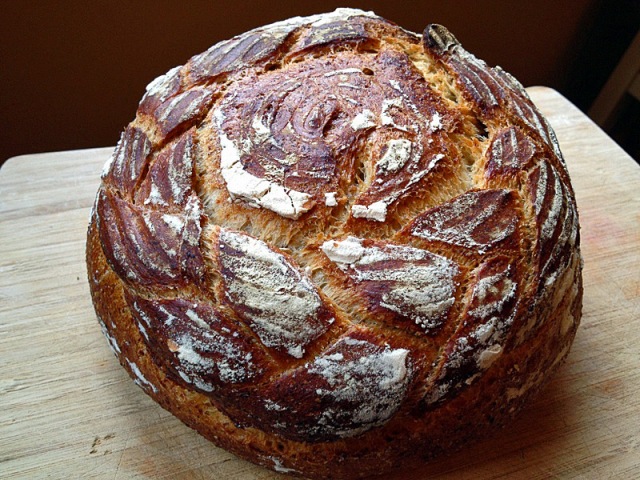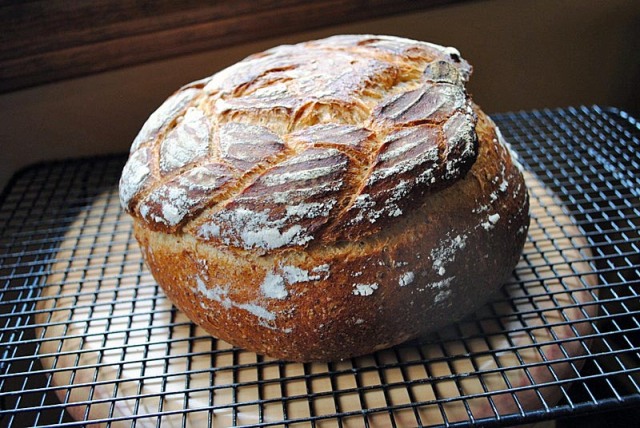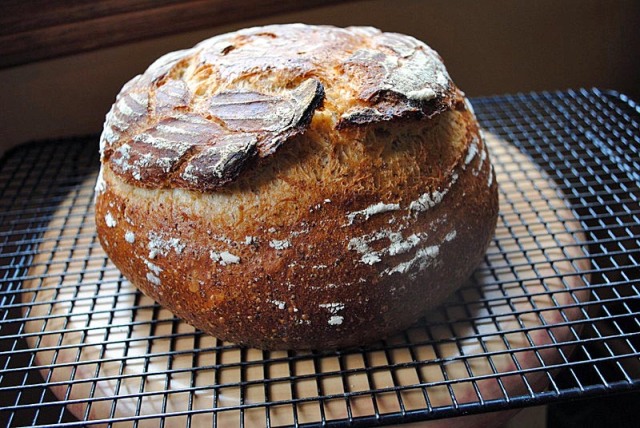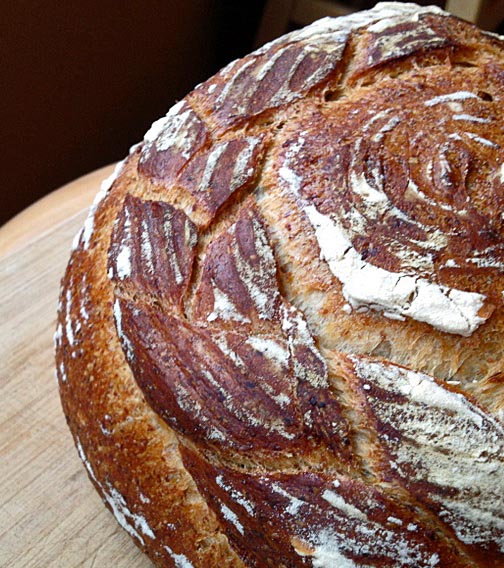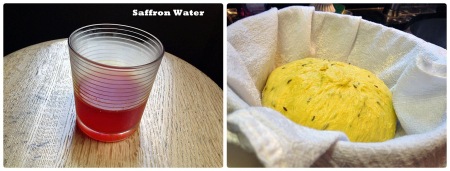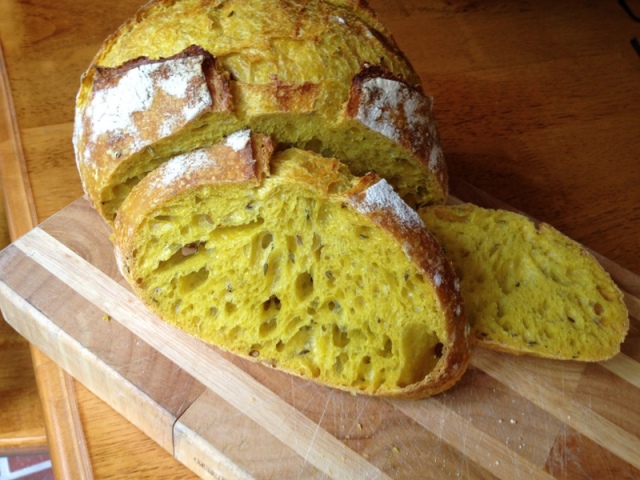On the last In My Kitchen post, I promised to come back to talk about a bread made with chestnut flour brought all the way from France. The Bread Baking Queen Farine was the one who got me into this bread adventure, and advised me to search for this exotic flour in Paris. When I sent her a photo of the bag I bought she was super excited because it turns out chestnut flour from Corsica is considered the best in the world! Amazing that it was exactly the type available near our hotel. Pure luck. With the stars so beautifully aligned, I was sure this would turn out as a wonderful baking project! Was I right? Well, let’s say that troubles were brewing faster than the wild yeast in my sourdough starter.
CHESTNUT SOURDOUGH BREAD
(from Farine’s blog)
(makes 4 small loaves)
For the pre-fermented dough
175 g mature white starter
494 g unbleached all-purpose flour
258 g water
26 g raw wheat germ (I used toasted)
12 g salt
For the final dough
750 g unbleached all-purpose flour
400 g chestnut flour
700 g water
450 g fermented white dough
5 g instant dry yeast
25 g salt
200 g whole, peeled cooked chestnuts, crumbled into chunks
For the fermented dough
Mix flour, water and white starter until the flour is well hydrated, cover with a cloth and let rest 20 minutes. Add salt and mix until you get a gluten window (when you stretch some of the dough really thin, you see strands of gluten and almost-see through spots). Put in an oiled bowl and cover tightly.
Let rise at room temperature for about two hours, then put in the fridge for up to 48 hours
Remove from the fridge at least two hours before using
For the final dough
Combine the flours in the bowl of the mixer, add the water and mix well. Cover with a cloth and let rest for 30 minutes
Add the fermented dough and yeast and mix until the dough is smooth and elastic. Sprinkle the salt over it and mix some more.
Very lightly flour your work surface. Place your dough on it, rough-side up, and flatten it out with your fingers. Spread the chestnut pieces over the top and press them well into the dough. Fold a few times so that all the chestnuts are incorporated into the dough. Form the dough into a ball, put it into an oiled bowl, cover with a cloth and let it rest for 40 minutes.
Lightly flour your work surface again, and turn the dough out on it. Fold the dough (on all four sides), then put back into your bowl, cover with baking cloth and let it rest for another 20 minutes. Lightly flour your work surface again, turn out the dough and divide it into 4 equal pieces. Shape as desired.
Place on a semolina dusted parchment paper over a sheet pan. Let rise, covered with baking cloths, for 1 ½ hour or until just doubled in volume.
Meanwhile turn on the oven to 500ºF/250ºC with a baking stone in it and an empty cast iron (or metal) pan on the bottom shelf. When ready to bake, score the breads the way you like, pour 1 cup of water in the cast iron (or metal) pan and slide the breads (still on their parchment paper) onto the baking stone, spray some water into the oven and close the door quickly.
After 5 minutes, turn the oven down to 440ºF/220ºC and bake for another 20 minutes. Check to see if the loaves need to be turned around or if they need to switch places, then bake for another 10 minutes as needed
Let cool on a rack.
ENJOY!
to print the recipe, click here
Comments: When you buy 500g of chestnut flour several thousand miles away from home, you become very protective of it A recipe that calls for 400g (in other words, 80% of my treasure) prompted me to launch a quick email to Farine, asking her thoughts on halving the recipe. She is far more experienced in sourdough baking than me, so when she speaks, I listen. Once she gave me the ok to go for it, I felt empowered, on top of the world. Yes, I will be able to bake this bread and have a lot of chestnut flour leftover to play with. How cool is that? So, being the super smart person I like to think I am, I made a nice table in which all amounts were cut in half, and went to work.
The catastrophic event was completely neglecting to look back at the table when mixing starter with the other components of the dough. I would have noticed that only HALF of the fermented dough should be added. So, that beautiful photo you see above, with a stretched out dough and the chestnuts waiting to be incorporated, was taken right before the piercing cry, the calling myself names, and the scared dogs running after Phil as he dashed out of the kitchen. It is shocking and appalling to realize how little sympathy I get from those who live with me.
It is not easy to think rationally under duress, but I figured that the only way out of my self-inflicted misery was to discard half of that dough (ouch, it hurt!) and add more of all other components to the other half, except (obviously) the starter. Two problems with this strategy: I would not have time to let the flours go through autolyse before mixing, and I would have to use more of my precious chestnut flour. With a heavy heart, that’s what I did.
I was absolutely sure the abused bread would turn out to be a complete failure, but the Gods of Bread are a lot kinder than the Gods of Golf, so all had a miraculous happy ending. Maybe the crumb turned out a little too tight, but I can tell you this bread tastes amazing! If you can find chestnut flour where you live, or if you can order it online, try this bread. And, I echo Farine with one piece of advice she gave me: it is ok to scale down the recipe, but do not substitute walnuts or other nuts. Chestnuts are essential…
MC, thanks for the constant inspiration, and sorry I messed up the recipe. There’s always next time, as long as I find a good source for chestnut flour here in the US. Amazon.com to the rescue? 😉
I am submitting this post to Susan’s Yeastspotting…
ONE YEAR AGO: Kinpira Gobo and Japanese Home Cooking
TWO YEARS AGO: Walnut Sourdough
THREE YEARS AGO: Thai Chicken Curry
FOUR YEARS AGO: Zen and the art of risotto








